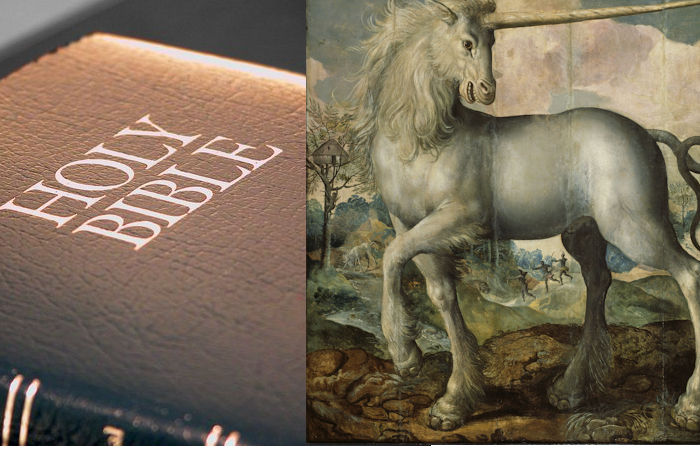The Unicorn In The Bible Was An Oryx – Ancient Translation Mistake
Ellen Lloyd - AncientPages.com - The unicorn is a legendary animal that has fascinated people for ages. Depictions of this magical and beautiful animal have been found on ancient seals, and early Greek writers believed the unicorn originated from India.
During the Middle Ages and Renaissance, people were incredibly interested in this mysterious creature no one had seen. As discussed in our previous article on Ancient Pages, Vikings used the opportunity and started selling faked unicorn horns and fooled Europeans with their bluff for hundreds of years.
Being in possession of a unicorn horn was everyone’s desire, but hardly possible due to the high price. It was believed that the alicorn, the horn itself, and the substance it was made of held magical and medicinal properties. Even the great painter Leonardo da Vinci was fascinated by the unicorn and wrote about it in his notebooks.
The Holy Bible. Credit: Kevin Probst - Public Domain - Unicorn by Maerten de Vos (1532–1603). Credit: Public Domain
Knowledge of the unicorn came from ancient Greek authors and the Bible, but no one knew the magical animal had been misidentified.
The Bible mentions the unicorn seven times, but only by mistake.
The mistake happened long before the birth of Christianity. The Old Testament was originally composed in Hebrew.
In 250 B.C., Ptolemy II Philadelphus, the second King of Egypt's Greek period, ordered 72 elders to translate the sacred Hebrew texts into Greek. That Greek translation is called the Septuagint. During the translation, the Jews encountered a problem. Their texts contained several references to an animal called "Re'em".
Re’em is the Hebrew name for oryx leucoryx or oryx, but the Jewish ancient scholars were confused by the descriptions in the Old Testament.
Left: Virgin Mary holding the unicorn (c. 1480), detail of the Annunciation with the Unicorn Polyptych, National Museum, Warsaw. Credit: Public Domain - Right: Maiden with Unicorn, tapestry, 15th century (Musée de Cluny, Paris). Credit: Public Domain
Modern Bible scholars believe that the Jewish texts are likely to refer to the two-horned oryx. Oryx leucoryx was once a lord of the entire Middle East. Its domain embraced most of the Land of Israel, but during the reign of King Ptolemy II Philadelphus, it had already been extinct in North Africa and the Middle East.
The original Jewish texts mention nothing about the animal having a horn, but the King's scribe chose, despite this, to call the animal monoceros, which can be translated into "a horn". The translation was continued when the Jewish texts became the Old Testament.
Unicorns still captivate modern people, and scientists have tried to find proof of their existence. Some years ago, a unicorn fossil was discovered in Siberia. The discovery caused a sensation. Scientists said unicorns were in fact real, but they looked slightly different from what we imagine today.
Written by Ellen Lloyd – AncientPages.com
Copyright © AncientPages.com All rights reserved. This material may not be published, broadcast, rewritten or redistributed in whole or part without the express written permission of AncientPages.com
More From Ancient Pages
-
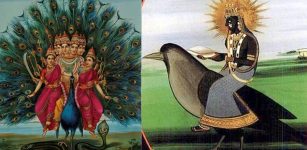 Vahanas – Sacred Animal Vehicles Of Hindu Gods And Goddesses
Featured Stories | Apr 30, 2017
Vahanas – Sacred Animal Vehicles Of Hindu Gods And Goddesses
Featured Stories | Apr 30, 2017 -
 Impressive Textile Reconstruction Shows What Viking Age People Dressed Like
Featured Stories | Sep 26, 2023
Impressive Textile Reconstruction Shows What Viking Age People Dressed Like
Featured Stories | Sep 26, 2023 -
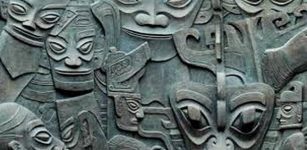 Baffling Sanxingdui Civilization: Why Did These People Have Fascination For Eyes?
Civilizations | Mar 21, 2017
Baffling Sanxingdui Civilization: Why Did These People Have Fascination For Eyes?
Civilizations | Mar 21, 2017 -
 Ancient Mesoamericans Drank Tobacco In Healing Rituals – Ceramic Vases From Cotzumalhuapa, Guatemala Reveal
Archaeology | Mar 6, 2024
Ancient Mesoamericans Drank Tobacco In Healing Rituals – Ceramic Vases From Cotzumalhuapa, Guatemala Reveal
Archaeology | Mar 6, 2024 -
 Why Did First Printed Books Scare Ancient Scholars In Europe?
Ancient History Facts | Sep 18, 2021
Why Did First Printed Books Scare Ancient Scholars In Europe?
Ancient History Facts | Sep 18, 2021 -
 Unusual Grave Of The Trzciniec Culture Is An Archaeological Puzzle
Archaeology | Dec 23, 2019
Unusual Grave Of The Trzciniec Culture Is An Archaeological Puzzle
Archaeology | Dec 23, 2019 -
 Strange Case Of The ‘Impossible’ Glove Remains Unexplained – The Investigation – Part 2
Featured Stories | May 28, 2019
Strange Case Of The ‘Impossible’ Glove Remains Unexplained – The Investigation – Part 2
Featured Stories | May 28, 2019 -
 Uncovering 16th Century Scottish Royal Dockyards Used By King James IV’s Navy
Archaeology | May 24, 2018
Uncovering 16th Century Scottish Royal Dockyards Used By King James IV’s Navy
Archaeology | May 24, 2018 -
 Gryla: Cannibalistic, Evil Troll And Her Sons ‘Yule Lads’ – In Icelandic Folklore
Christmas Traditions | Dec 23, 2024
Gryla: Cannibalistic, Evil Troll And Her Sons ‘Yule Lads’ – In Icelandic Folklore
Christmas Traditions | Dec 23, 2024 -
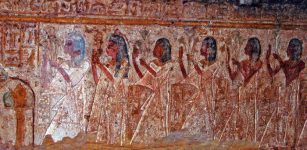 Rock-Cut Tomb Of Pennut, Viceroy Of Nubia Under Reign Of Ramses VI
Civilizations | Dec 7, 2018
Rock-Cut Tomb Of Pennut, Viceroy Of Nubia Under Reign Of Ramses VI
Civilizations | Dec 7, 2018 -
 Werewolf – Ancient Worldwide Belief In Terrible Curse
Myths & Legends | Jun 28, 2021
Werewolf – Ancient Worldwide Belief In Terrible Curse
Myths & Legends | Jun 28, 2021 -
 Controversial Statue Of Anglo-Norman Knight William Marshal In Pembroke Faces Criticism
Artifacts | May 10, 2022
Controversial Statue Of Anglo-Norman Knight William Marshal In Pembroke Faces Criticism
Artifacts | May 10, 2022 -
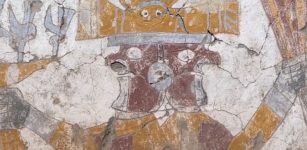 Ancient Murals Of Mysterious Two-Faced Beings And Supernatural Creatures At Pañamarca, Peru
Archaeology | Mar 21, 2023
Ancient Murals Of Mysterious Two-Faced Beings And Supernatural Creatures At Pañamarca, Peru
Archaeology | Mar 21, 2023 -
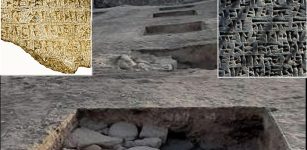 Monumental Structure Unearthed During Excavations Of Urartu-Era Karmir Blur
Archaeology | Nov 25, 2022
Monumental Structure Unearthed During Excavations Of Urartu-Era Karmir Blur
Archaeology | Nov 25, 2022 -
 Runic Inscription On The Forsa Ring Is Not What We First Thought – Scientists Say
Archaeology | Aug 15, 2024
Runic Inscription On The Forsa Ring Is Not What We First Thought – Scientists Say
Archaeology | Aug 15, 2024 -
 Abundantia: Roman Goddess Who Was Shaking Her Gifts From Cornucopia – ‘Horn Of Plenty’
Featured Stories | Nov 4, 2019
Abundantia: Roman Goddess Who Was Shaking Her Gifts From Cornucopia – ‘Horn Of Plenty’
Featured Stories | Nov 4, 2019 -
 Mysterious Ancient Female Society Discovered – What Happened To All The Men? Archaeologists Wonder
Featured Stories | Oct 3, 2024
Mysterious Ancient Female Society Discovered – What Happened To All The Men? Archaeologists Wonder
Featured Stories | Oct 3, 2024 -
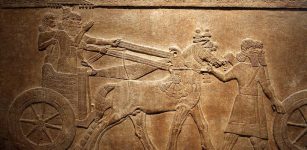 Pax Assyriaca: Important Time For The Neo Assyrian Empire And Surrounding Regions
Ancient History Facts | Aug 11, 2016
Pax Assyriaca: Important Time For The Neo Assyrian Empire And Surrounding Regions
Ancient History Facts | Aug 11, 2016 -
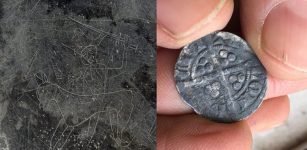 Rare Viking Graffiti And Artifacts Found In Dublin – Depiction Of God Odin Riding Sleipnir Followed By Huginn And Muninn?
Archaeology | Mar 31, 2018
Rare Viking Graffiti And Artifacts Found In Dublin – Depiction Of God Odin Riding Sleipnir Followed By Huginn And Muninn?
Archaeology | Mar 31, 2018 -
 On This Day In History: Mathematician And Astronomer Christiaan Huygens Born – On Apr 14, 1629
News | Apr 14, 2017
On This Day In History: Mathematician And Astronomer Christiaan Huygens Born – On Apr 14, 1629
News | Apr 14, 2017

